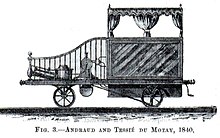Compressed air locomotive
Compressed air locomotives or compressed air locomotives are piston locomotives that carry compressed air in high pressure bottles for their operation. In the past, they were primarily used as mine locomotives in underground coal mining or in the chemical industry, because they do not need a fire to operate and they can therefore also be used in ignitable environments.
Compressed air locomotives must be supplied with compressed air again at the designated stations. Because of the cramped conditions using compressed air locomotives are usually as narrow gauge - vehicles running.
history
At the beginning of the 19th century, a Mr. Baader from Munich presented a compressed air locomotive. The proposal was implemented by Henschel & Sohn in Kassel in 1833 .
The inventor Antoine Andraud and the chemist Cyprien Marie Tessié du Motay from Paris built a vehicle with compressed air drive in 1839, which carried out test drives between Paris and Versailles in July 1840 , but without pulling a car. However, the vehicle already had a device called a heat box for heating the air at the pressure reducer , so that the evaporative cold that occurs when the compressed air is released should not form ice in the cylinders. The test vehicle had a 500 liter air tank which was charged with 16 atm of compressed air which was relaxed to 4 atm before being fed to the cylinders. In a test drive with eight people on the car, it only made it 1000 m before the compressed air was used up. The average speed was 10 French miles an hour, which is 39 km / h.
In 1850 Andraud built a locomotive for 100 atm boiler pressure. The pressure could not be achieved, however, because no suitable drive machines were available for the compressors and they therefore had to be driven by hand.
gallery
Compressed air locomotive for the construction of the Gotthard tunnel
Pneumatic locomotive for the construction of the Simplon Tunnel
Compressed air locomotive at the mining museum in Bochum
See also
- Soda locomotive
- Gas expansion engine
- Steam storage locomotive or fireless locomotive
literature
- Victor von Röll : compressed air locomotives (encyclopedia entry). In: Encyclopedia of Railways. 2nd edition, Urban & Schwarzenberg, Berlin / Vienna 1912–1923. 1923, Retrieved March 5, 2019 .
Web links
Individual evidence
- ↑ a b A.L. Crelle: Mémoire sur les différentes manières de se servir de l'élasticité de l'air atmosphere comme force motrice sur les chemins de fer . In: Journal for pure and applied mathematics . Duncker and Humblot, 1846, p. 20 ( google.com [accessed January 8, 2020]).
- ↑ Antoine Andraud, Cyprien Marie Tessie du Motay: De l'air comprimé et dilate comme moteur ou des forces naturelles, recueillies gratuitement et mises en réserve . 2nd Edition. Guillaumin, Paris 1840 ( bnf.fr [accessed January 8, 2020]).
- ↑ a b About various railway systems . In: Allgemeine Bauzeitung Wien . 1846, 2nd application of compressed air as a moving force. System Andraud, S. 16-18 ( google.cz [accessed January 8, 2020]).
- ↑ a b HEFTI: Steam trams . Springer-Verlag, 2013, ISBN 978-3-0348-6512-8 , compressed air locomotives and compressed air railcars, p. 68 ff . ( google.com [accessed January 8, 2020]).
- ↑ Alexander Huber: Technical, economic and ecological analysis of alternative drive technologies: Case Study: The air-powered vehicle Aircar from MDI . diplom.de, 2004, ISBN 978-3-8324-8442-2 , p. 48 ( google.de [accessed on January 8, 2020]).




